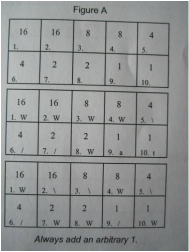The Classification Formula
Let’s begin by holding up ten (10) fingers.
Start with the right thumb.
The right thumb is number (one) 1.
The right index finger is number (two) 2. The right middle finger is number three
(3). The right ring finger is
number four (4). The right little
finger is number five (5). The
left thumb is number six (6). The
left index finger is number seven (7).
The left middle finger is number eight (8).
The left ring finger is number nine (9). The left little finger is number ten
(10). If one is taking impressions
of fingerprints, the processor would begin with the right hand. The processor
would lift the right thumb, and either using LiveScan (computerized) or ink,
place the person’s fingertips on the computer glass or in the ink and roll the
thumb from tip to tip. If the
print is rolled in ink, the processor will lift the fingers and roll the
impression, from tip to tip left to right onto the identification card. The impression of the thumb is placed in
the fingerprint box labeled 1 in the bottom left corner.
The fingers two (2) - five (5) will be rolled from tip to tip left to
right. Each fingerprint impression
will be placed in the corresponding fingerprint box. The processor would repeat
each step with the subject’s left hand, except the impressions will be rolled
from tip to tip right to left in each finger’s respective
block.
Primary-
The primary classification is the sum of the pattern types. Each
finger block is assigned numerical values.
Fingers 2, 4, 6, 8, and 10 will be used as the numerators. Fingers 1, 3, 5, 7, and 9 will be used
as the denominator. A one (1) is
always added to the numerator and denominator.
A whorl will always assume the definite value of the fingerprint
block, but the other patterns (loops and arches) will be disregarded when
computing the summation of the primary classification.
**See figure A (Forensic Press, 2000).
Secondary-
The secondary classification is
derived from the pattern type of the index fingers.
Fingers two (2) and seven (7) will serve as the numerator and denominator respectively. For example, if fingers two (2)
and seven (7) is a plain arch and a tented arch it would look like this
A/T.
Small Letters-
Small letters are place on the numerator or denominator depending on
their respective place from
the index fingers. Fingers two (2)
and seven (7) are the only capital letters.
Let’s begin by holding up ten (10) fingers.
Start with the right thumb.
The right thumb is number (one) 1.
The right index finger is number (two) 2. The right middle finger is number three
(3). The right ring finger is
number four (4). The right little
finger is number five (5). The
left thumb is number six (6). The
left index finger is number seven (7).
The left middle finger is number eight (8).
The left ring finger is number nine (9). The left little finger is number ten
(10). If one is taking impressions
of fingerprints, the processor would begin with the right hand. The processor
would lift the right thumb, and either using LiveScan (computerized) or ink,
place the person’s fingertips on the computer glass or in the ink and roll the
thumb from tip to tip. If the
print is rolled in ink, the processor will lift the fingers and roll the
impression, from tip to tip left to right onto the identification card. The impression of the thumb is placed in
the fingerprint box labeled 1 in the bottom left corner.
The fingers two (2) - five (5) will be rolled from tip to tip left to
right. Each fingerprint impression
will be placed in the corresponding fingerprint box. The processor would repeat
each step with the subject’s left hand, except the impressions will be rolled
from tip to tip right to left in each finger’s respective
block.
Primary-
The primary classification is the sum of the pattern types. Each
finger block is assigned numerical values.
Fingers 2, 4, 6, 8, and 10 will be used as the numerators. Fingers 1, 3, 5, 7, and 9 will be used
as the denominator. A one (1) is
always added to the numerator and denominator.
A whorl will always assume the definite value of the fingerprint
block, but the other patterns (loops and arches) will be disregarded when
computing the summation of the primary classification.
**See figure A (Forensic Press, 2000).
Secondary-
The secondary classification is
derived from the pattern type of the index fingers.
Fingers two (2) and seven (7) will serve as the numerator and denominator respectively. For example, if fingers two (2)
and seven (7) is a plain arch and a tented arch it would look like this
A/T.
Small Letters-
Small letters are place on the numerator or denominator depending on
their respective place from
the index fingers. Fingers two (2)
and seven (7) are the only capital letters.

